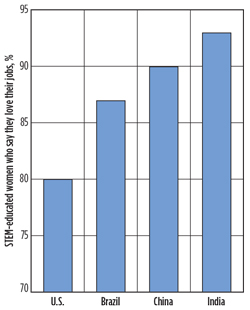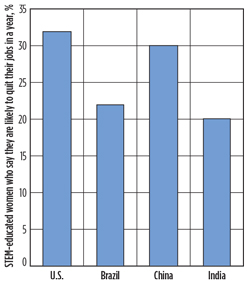As the demand for science, technology, engineering and mathematics (STEM) talent increases across multiple job sectors, the battle to attract and retain top talent intensifies. There are huge implications in the oil and gas industry, where diversity of thought and backgrounds is of the utmost importance to businesses, especially as it relates to women.
At BP, we invest more than $500 million each year in formal and informal learning and development programs, as part of our ongoing commitment to not only attract talent overall, but to attract and retain talented women with STEM backgrounds. The good news is that the industry has seen an increased representation of women over the last few decades, and there are now more career opportunities for females with STEM degrees than ever before. In fact, a recent BP-sponsored Center for Talent Innovation (CTI) study, “Athena Factor 2.0: Accelerating Female Talent in Science, Engineering and Technology,” quotes the 2010 findings of the U.S. Bureau of Labor Statistics, stating that science, engineering and technology jobs will increase 17% between 2008 and 2018, a growth rate nearly twice that of fields outside those areas. The report also reaffirms that women in the industry, just like their male counterparts, expect to lead rich, fulfilling, professional and personal lives.
The Athena 2.0 study revealed that, in many locations, women are the majority of STEM college graduates. However, the research also identifies several challenges that continue to daunt women as they look to pursue careers in STEM and fill in the “skills gap” as qualified candidates. The data show isolation, scarcity of effective sponsors and mentors, a male-dominant environment and difficulty with executive presence as common themes that make it challenging for women to enter the industry, and grow into leadership roles. The industry must continue to demonstrate that it realizes the challenges and continues to offer women rewarding career paths.
While attracting top female STEM talent is a priority, it is just as important to retain them. According to the CTI study, female STEM employees are ambitious, eager to be promoted, and dedicated to their professions: 80% of U.S., 87% of Brazilian, 90% of Chinese and 93% of Indian STEM-educated women say they love their work, Fig. 1. Why? Because they find it intellectually challenging and stimulating, and they thrive on grappling with new ideas that can drive innovation and improve business results.
 |
| Fig. 1. With intellectually challenging, stimulating work environments, many of the STEM-educated women surveyed said that they love their jobs. |
|
But, the study also reports that many women feel stalled in their careers, and are likely to quit their jobs in a year: 32% in the U.S., 22% in Brazil, 30% in China and 20% in India, Fig. 2. While it is known that stories of isolation increase as women climb the corporate ladder in many industries, women in STEM roles say they find it particularly difficult. As an industry, we must strive to demonstrate and foster a more inclusive working environment that helps women advance into, and feel supported in, leadership roles. One way that BP is responding to this need is by setting clear objectives: We are working toward our goal for 25% of group leaders and 30% of our senior level leaders to be women by 2020. Board diversity also remains important to us, and we continue to work for a quarter of our board to be female by the end of 2015.
 |
| Fig. 2. While many of women surveyed felt positively about their work, some reported feeling stalled, and said that they were likely to quit their jobs in a year. |
|
There are several key factors for retaining top women in the industry. These include appropriate internal resources, such as learning and development opportunities, being more transparent about how to achieve career progression, and robust sponsorship and mentoring programs. Further, properly implemented, agile working arrangements, and leadership education about workplace flexibility, are known factors that allow all employees to thrive, both professionally and personally.
Learning and development are often the most important objectives that employees, especially Millenials and women, want from a potential employer. Successful companies invest in professional development to equip women with both technical and interpersonal skills, to help them navigate the workplace and grow their careers.
Career advancement is also a significant factor in attracting and retaining female employees in oil and gas. Women in STEM are highly educated and have many options. According to a study conducted by Rigzone, and analyzed by the U.S. Bureau of Labor Statistics, 46% of all new jobs in the industry went to women during first-quarter 2013. This is the highest representation level in years. As an industry, we must reinforce this positive trend by continually demonstrating career growth and leadership opportunities for female employees.
One of the challenges that companies often face is the perceived lack of senior female role models within those organizations. At present, over 17% of BP’s top 500 leaders, and just over 19% of its top 5,000 leaders, are female, with both percentages having shown increases over the last two years. At BP, leaders are expected to assess staffing decisions, to check that there is no bias getting in the way of the company’s long-term diversity and inclusion strategy, and to analyze team composition for balance across different aspects of diversity. Consistent reporting mechanisms track progress toward diversity goals and inform our decision-making. The end goal is to ensure that career paths and requirements for advancement are more clearly defined, and the right training and procedures are in place, so that women feel empowered to take the steps necessary to advance.
Business resource groups (BRGs) are voluntary, employee-initiated and driven groups open to all interested employees across the organization. Their objectives are to focus on the business, through delivering a return on investment to the organization. BRGs work to assist the business with efforts to attract, retain and develop their constituency group, as well as promote the company’s brand in the marketplace. We have successfully aligned these groups in service of the broader diversity and inclusion organizational strategy. Examples of BRG focus areas include veterans, women, wisdom and experience, race/ethnicity, LGBT and acclimation to new workplace cultures. One of the largest, and most active, BRGs at BP is the Women’s International Network (WIN). Whether it’s hosting women-centric events, such as the Global Connectivity Event, participating in international initiatives, such as International Women’s Day or Girl’s Day, or regularly holding focus groups and roundtable sessions to proactively and regularly address the concerns and challenges facing women in the industry, this group works to share, inspire and advance women every day.
Sponsorship provides critical avenues for advancement within organizations, according to the CTI study. Sponsorship, in particular, is understood by leading-edge companies to bridge chasms, not just for women, but also for minorities. In particular, sponsorship helps female talent navigate the unwritten rules and “code of executive presence, improving their chances of being perceived as leadership material.” Research shows that women with sponsors are 70% more likely to have their ideas endorsed, 119% more likely to see them developed, and 200% more likely to see them implemented.
Agile working arrangements, also called “workplace flexibility,” are important and essential to today’s women and men, alike. When a company has a clear policy in place to accommodate work/life blending, with managers educated on the value of agile working, it helps eliminate the “guilt factor” often associated with the need to take time away from the office for personal activities and appointments, parenting or family commitments. It also demonstrates to employees and prospective employees that their employer is committed to them as a holistic person, not just a scientist, engineer or other professional. Feeling supported on both the professional and personal levels leads to increased levels of employee satisfaction and happiness, which leads to greater retention and greater discretionary efforts applied to the business.
As an industry, we are all responsible for growing, developing and retaining our diverse talent pool. It is increasingly understood that diversity of thought, perspectives and backgrounds can fuel innovation. It is also well understood that having a workforce that reflects the societies in which we operate is not just good for business, it is often a requirement to operate in many countries.
Working to achieve proportionate representation of women at each level within the organization is a goal that many companies strive to achieve. It requires implementing active programs and systems to identify missed opportunities and working to eliminate them. Undoubtedly, attracting a wide range of talented people is vital to any oil and gas company’s continued growth and success, and will help the organization remain competitive.
While we recognize that the industry has made, and continues to make, strides in attracting a diverse workforce, we are committed to doing more to attract and retain our fair share of talented people. Our business growth depends on it. The entire industry only stands to gain from the equitable representation of women throughout every area of the business. 
REFERENCES
- Hewlett, S. A., L. Sherbin, F. Dieudonné, C. Fargnoli and C. Fredman, “Athena 2.0: Accelerating female talent in science, engineering and technology,” Center for Talent Innovation, 2014.
|




